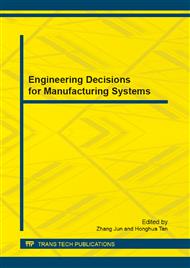[1]
Z.G. Yao, L. Cheng and Q.L. Wang. Sensor fault detection, diagnosis and validation-a survey. Applied Mechanics and Materials. Vol. 229-231: 1265-1271, (2012).
DOI: 10.4028/www.scientific.net/amm.229-231.1265
Google Scholar
[2]
S.X. Ding, P. Zhang, A. Naik, E.L. Ding and B. Huang. Subspace method aided data-driven design of fault detection and isolation systems. Journal of process control, 19(2009): 1496-1510.
DOI: 10.1016/j.jprocont.2009.07.005
Google Scholar
[3]
Y. L Wang, G.F. Ma, S.X. Ding and C.J. Li. Subspace aided data-driven design of robust fault detection and isolation systems. Automatica, 47(2011): 2474-2480.
DOI: 10.1016/j.automatica.2011.05.028
Google Scholar
[4]
R.J. Patton, P.M. Frank, and R.N. Clark. Issues of fault diagnosis for dynamic systems. Berlin: Springer-Verlag, (2000).
Google Scholar
[5]
J. Chen and R.J. Patton. Robust model-based fault diagnosis for dynamic systems. Boston: Kluwer academic publishers, (1999).
Google Scholar
[6]
S.X. Ding. Model-based fault diagnosis techniques design schemes algorithms and tools. Berlin: Springer-Verlag, (2008).
Google Scholar
[7]
S.J. Qin. Statistical process monitoring: basics and beyond. J. Chemometrics 2003, 17: 480-502.
DOI: 10.1002/cem.800
Google Scholar
[8]
J.E. Jackson. A user's guide to principal components. Wiley Interscience, New York, USA, (1991).
Google Scholar
[9]
I.T. Jolliffe. Principal component analysis. Spring Verlag, Berlin, (1986).
Google Scholar
[10]
S. Valle, W. Li and S.J. Qin. Selection of the number of principal components: the variance of the reconstruction error criterion with a comparison to other methods. Industrial and Engineering Chemistry Research, 38(11): 4389-4401, (1999).
DOI: 10.1021/ie990110i
Google Scholar


